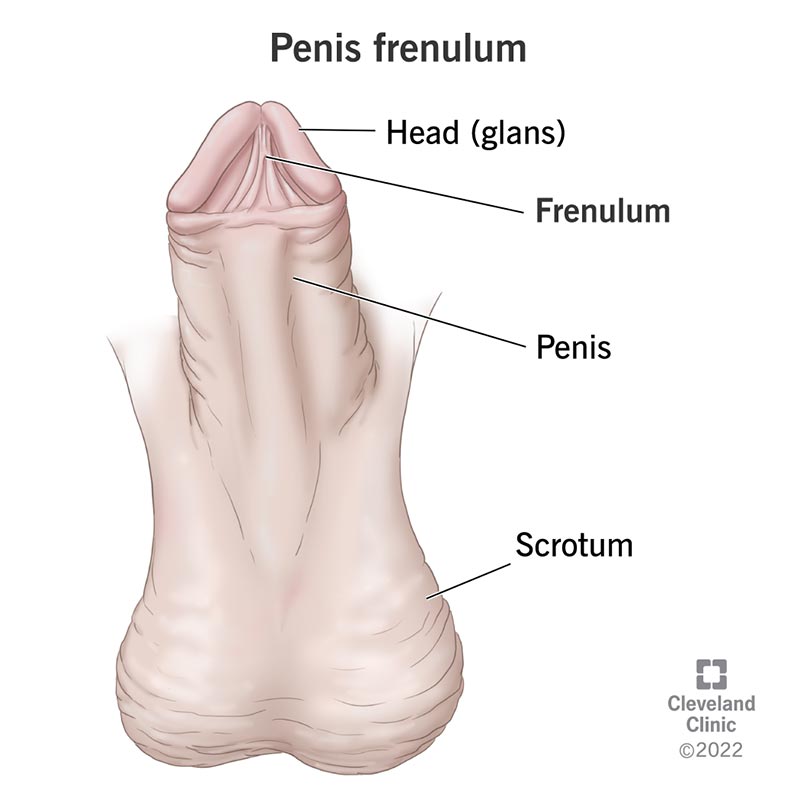The frenulum of the penis is a band of tissue that connects the foreskin to the head (glans). It can sometimes pull the head of your penis down. The frenulum can also sometimes tear.
Advertisement
Cleveland Clinic is a non-profit academic medical center. Advertising on our site helps support our mission. We do not endorse non-Cleveland Clinic products or services. Policy

The frenulum of your penis is a band of tissue found where your foreskin (prepuce) intersects with the head (glans) of the underside of your penis. Even if you have a circumcised penis, a small piece of the frenulum may remain. It’s often shaped like the letter “V.”
Advertisement
Cleveland Clinic is a non-profit academic medical center. Advertising on our site helps support our mission. We do not endorse non-Cleveland Clinic products or services. Policy
The frenulum of the penis has other names, including frenum and “banjo string.”
The frenulum is very sensitive, especially to a light touch. It’s believed to help pull back the foreskin over the glans of your penis. The frenulum is part of the sexual arousal process, but it can also cause pain with erection if it’s too short.
Typically, the frenulum is on the underside of your penis (the side closest to the scrotum). The frenulum looks a bit like a bridge of tissue connecting your foreskin to the head of your penis.
“Frenum” in Latin means “bridle,” so “frenulum” means “little bridle.” The band of tissue does connect and restrict organs. You also have a frenulum under your tongue, as well as other places in your body.
Conditions that can affect the frenulum of the penis include:
Advertisement
The most common signs and symptoms of frenulum problems include:
Your healthcare provider will rely on questions regarding your medical history and a focused physical examination.
You can usually treat a torn frenulum at home by rest, over-the-counter pain relievers and waiting to have sex or masturbate until you heal. If the frenulum isn't healing well, if it's painful or if it tears too often, you should contact your healthcare provider. At that point, your provider may talk to you about these common treatments:
The surgeons will take care not to nick the urethra when doing these procedures. The urethra lies below the frenulum.
Frenuloplasty and frenulectomy are quick surgeries, usually performed in a urologist’s office or an outpatient surgery center. Your provider will discuss what type of anesthesia would be best for you.
Keeping your penis clean and dry is good for you and your frenulum. Make sure you wear clean underwear and clean clothing.
It’s also important to know what your penis looks like and feels like normally. If you have any signs or symptoms that anything has changed, contact your healthcare provider.
If you’re having no issues with your frenulum (such as pain, bleeding, problems with sex or hygiene), there’s no reason to have it removed.
Yes, it’s normal to have a frenulum of the penis. It’s also normal not to have one in some medical conditions.
Yes, a surgeon can remove the frenulum of the penis. Your healthcare provider may suggest this if you’ve had repeated tears and have developed scar tissue. You may want a frenulectomy (frenulum removal) if the frenulum is causing physical pain or causing your penis to curve downward.
If you have a penis, you may or may not have a frenulum, which is a piece of tissue that connects your foreskin to the head of your penis, also called the glans. A circumcised penis may have a partial frenulum or no frenulum at all. Sometimes a frenulum of the penis can tear during vigorous sexual activity. If that happens, the frenular artery can bleed, and that can be scary. These kinds of tears usually heal on their own, but there may be cases when your healthcare provider suggests lengthening or removing the frenulum. Discuss these options with your healthcare provider to make the best decision for you.
Advertisement
Cleveland Clinic’s primary care providers offer lifelong medical care. From sinus infections and high blood pressure to preventive screening, we’re here for you.

Last reviewed on 07/25/2022.
Learn more about the Health Library and our editorial process.